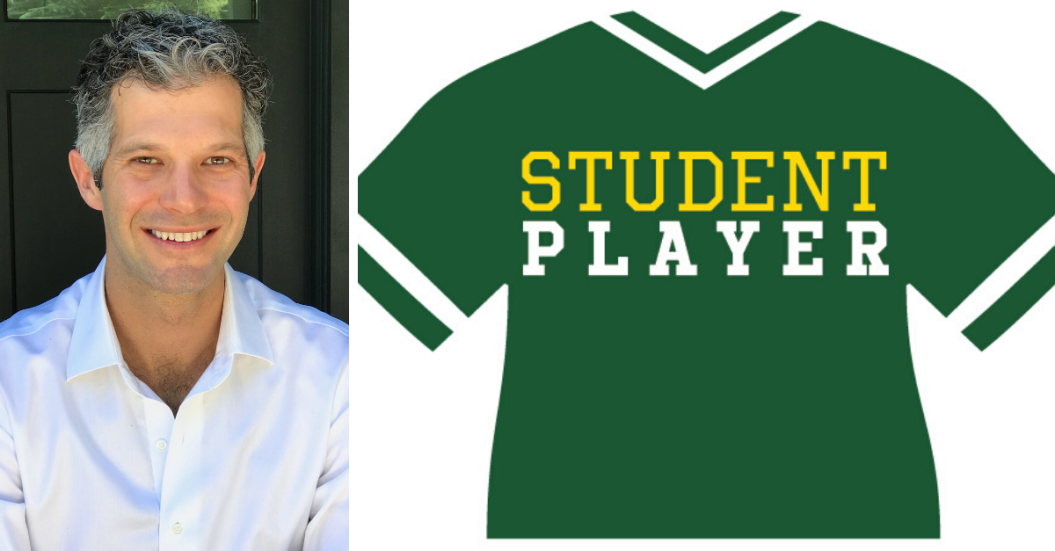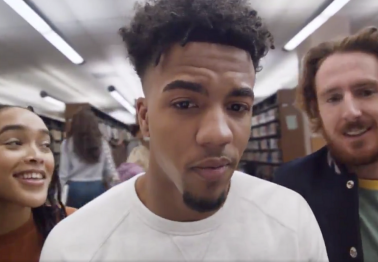College kids get by with the bare minimum. They splurge on pallets of ramen noodles, strategically plot "free coffee" stands during finals week, and work night jobs in bars just to get by. You might think every college athlete has it made with scholarship money and the "benefits" of playing a sport, but the reality is that many athletes still struggle with living expenses alongside massive time commitments asked of them by their university.
The NCAA generated over $1 billion of revenue during the 2016-17 school year. How? By advertising Division I men's basketball players in the March Madness tournament and promoting softball players for the Women's College World Series, among many other channels. Student-athletes — only two percent of whom turn pro — are beloved in their towns, yet cannot sign autographs for money, make appearances at local events for cash, or have use of their name, image and likeness without violating the NCAA's outdated guidelines on "amateurism" in college sports.
The wheel is breaking, though. The Fair Pay to Play Act was passed in 2019 by California Gov. Gavin Newsom, after which the NCAA voted unanimously to allow students the opportunity to make money using their N.I.L. in a way that upholds the values of the student-athlete. This process isn't concrete, as the NCAA Board of Governors continues to debate guidelines for this process, but some are getting ahead of the game to help these kids, finally, put money in their pockets.
Enter Zachary Segal, the founder of StudentPlayer.com.
"In brainstorming what a post-name-image-likeness world would look like, I came up with the idea," Segal told FanBuzz in a phone interview. "Fans are going to want to get involved with their team. And if you think about this — crowdfunding by position — is a way that someone can contribute right now and have an impact on the players that their team ends up getting."
Here's how Student Player works: Let's say you're a fan of the Alabama Crimson Tide. You, as a fan, can contribute to a sponsorship that directly benefits any starting position you want; Every position from running back to longsnapper is in play. Now, if you'd rather contribute to an entire team, you do so without specifying a position, and your donation is spread amongst every player using what Student Player calls the "Maximum Team Strength Allocation." (SP weights the importance of each position with this model. Wide receivers, for example, get six percent, the left tackle gets four percent, and cornerbacks get five percent. Check the full breakdown here.)
To be clear: we're not just talking about football players. Are you a Florida State softball fanatic? Donate to the entire team. Can't get enough Auburn gymnastics in your life? Help those girls put money in their pockets.
What is StudentPlayer.com?
For prospective high school student-athletes, Student Player represents a vital tool in their recruiting process. Not only would education, campus life, team facilities and coaching be a factor, now college athletes can also see what schools have money-making opportunities, all of which would go directly into their pockets.
"I think that, ultimately, players are going to look to Student Player to see what kind of sponsorship opportunities exist and weight that heavier in their decision of where to play than something like a $28 million locker room, which LSU [football] has," Segal said.
After an athlete accepts a sponsorship opportunity via Student Player, they'd fulfill their sponsorship obligation right from their smart phone. In a few, quick posts that take only minutes, these athletes use their platform to become, in essence, social media influencers for local brands and businesses.
The ease of use and preserving a student-athlete's day-to-day life is what Segal believes separates Student Player's model from the rest.
"That appealed to me a lot because I was worried that, from my own college experience of seeing how much time goes into practicing and playing on the team, that once you get off the field, there's going to be this intense pressure to go meet with your agent and endorse a local business and show up at a booster's birthday party. You know, all sorts of things that could potentially prevent someone from being a college student. What's very appealing to me is this preserves the student in student-athlete."
Segal received his Bachelor's from Brown University and studied law and business at New York University. During his college years is where he first realized the time commitment student-athletes were putting in. In return, they were simply pursuing their passion for the game and "could not go out and benefit from their name, image and likeness the way anyone else could."
Should College Athletes Be Paid?
Name. Image. Likeness.
Three words that have haunted NCAA officials for the better part of a decade. What started with O'Bannon v. NCAA grew into a movement to help the student-athletes working, essentially, pro bono for billion-dollar institutions. In that landmark court case, former UCLA basketball player Ed O'Bannon, who was the NCAA Tournament's Most Outstanding Player in 1995, spearheaded a lawsuit against the NCAA. O'Bannon acted as lead plaintiff for a group of former players — they included icons like Oscar Robertson and Bill Russell — who argued student-athletes were entitled to financial compensation post-graduation.
When you watched the NCAA Tournament and saw promotional content of Zion Williamson in a Duke jersey, or tuned into College Football Playoff coverage to see Ohio State's Justin Fields tossing touchdowns, those are the kinds of free-of-charge uses of name and image O'Bannon's class action lawsuit were targeting. (The lawsuit began after an EA Sports video game included a player who wore UCLA jersey No. 31, was bald-headed, stood 6-foot-8, and shot left-handed. Spoiler: it was O'Bannon, yet he never authorized Electronic Arts to do so.)
The court ruled in favor of O'Bannon, which the NCAA subsequently appealed. In 2016, seven years after the initial filing, the U.S. Supreme Court denied to review the case, leaving student-athletes and "amateurism" of college athletics in limbo once again.
Some specifics of Student Player's sponsorship deals are still in flux. For example, when Florida quarterback Feleipe Franks went down with a season-ending injury in 2019, where would those sponsorship dollars funnel? They could shift to new starter Kyle Trask, but as Segal points out, these play-to-play ebbs and flows of the game raise new barriers to navigate. A commonsense solution says to pay starters at the beginning of every week, but that creates other challenges for sports, like basketball or softball, where multiple games are played each week.
One thing is certain: Segal believes Student Player could increase deep-seeded rivalries between fans hoping to finally have a say in their program, aside from showing up with noise makers and school spirit on game day.
"Is a large fan base important? Or is it the intensity of the fan base? What's going to make the biggest impact? If one school, let's say Duke basketball's fan base, steps up, is that going to cause [North Carolina's] to do the same? There is a huge competitive element I think, which will be engaging and fun for fans to participate in."
One important thing to note is that Student Player will allocate every penny from its crowdfunding to the student-athletes. The company takes no commissions and plans to support its business through advertising and other sources of income. In addition, utilizing endorsement deals in no way binds a student-athlete directly with the company, but instead, enhances the athlete's personal brand.
And if these new rules fall through, the NCAA rejects third-party opportunities for student-athletes to benefit from their N.I.L., and Student Player is ultimately left in the dark? The money would be funneled to the school it was originally intended for in support of the university or college itself. Student Player vows to keep none of it.
As of January 2020, Student Player holds over $103,000 in total contributions that will sit in escrow until NCAA legislation is passed, and hopefully, the hard work, countless hours of dedication, and thousands of tickets and merchandise sold by these young men and women will finally be rewarded.



